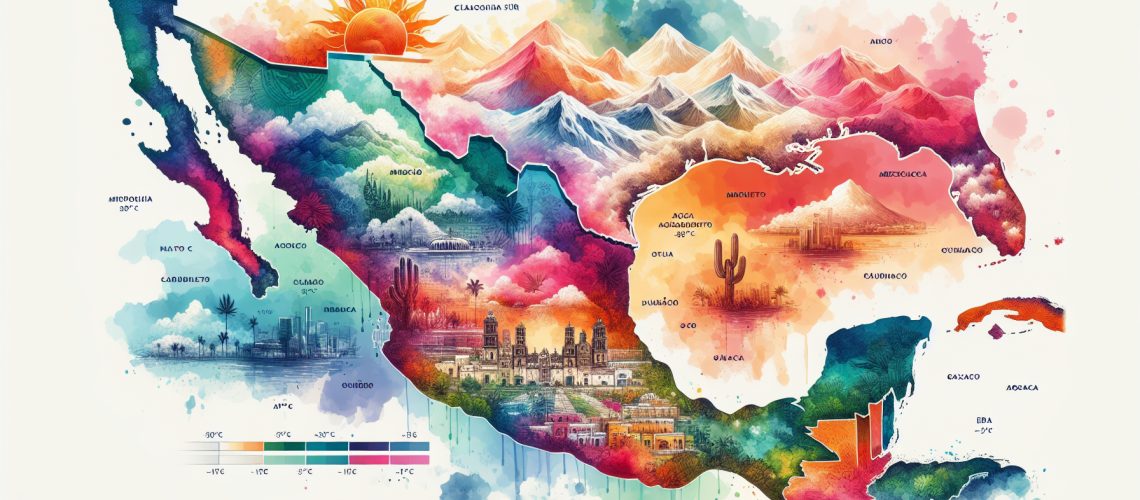Exploring the Diverse Climate of Mexico: Insights by Region
Mexico is a land of contrasts, where the climate varies significantly from one region to another. As you traverse this vibrant country, you may encounter everything from sweltering heat to freezing cold. With some areas, like Baja California Sur, Aguascalientes, and Mexico City experiencing highs between 86°F and 95°F, you’re bound to feel the warmth. In stark contrast, places such as Michoacán, Guerrero, and Oaxaca can see temperature spikes beyond 104°F, showcasing the extremes that exist within Mexico’s meteorological landscape.
Regional Variations: Heat and Chill
In mountainous regions, including Chihuahua and Durango, the climate shifts drastically. Here, winter nights can plunge as low as 14°F to 23°F, and frost is not uncommon. Imagine going from warm, sun-drenched beaches to icy mountain peaks—all within the same country!
The Heart of the Country: Mexico City
Headed to Mexico City? You’ll most likely be greeted by sunny skies ranging between 45°F to 79°F during this season. The bustling capital is characterized by gentle breezes and usually dry weather, as rainfall is a rare sight. This makes city exploration pleasant, whether you are savoring street tacos or hiking up to Chapultepec Castle.
If Wind Could Speak: Conditions in Chihuahua and Durango
However, in regions like Chihuahua and Durango, the wind can sometimes express its own stories. These areas frequently experience robust gusts, with speeds that may exceed 56 mph, offering a dramatic change from the calm in Mexico City. Such robust winds can also complicate outdoor plans for travelers, urging caution for those intent on venturing out.
Weather Trends Across Mexico: A Closer Look
Overall, the climate of Mexico flaunts a warm ambiance in many territories, with striking contrasts in its mountainous areas experiencing considerable cold. The interplay of weather patterns enhances not just the everyday life of locals, but also shapes the travel experiences of visitors. Let’s explore how these dynamics create a tapestry of weather that tells the unique stories of each region.
Tourism Considerations: What to Expect
When preparing for your journey throughout Mexico, understanding the climatic differences is crucial. For instance, packing layers will serve travelers well; lightweight clothing is perfect for warmer cities, but those venturing into the mountains might want to bring warmer attire for the chilly nights. After all, flexibility is key when traversing a country with such remarkable climatic diversity!
Let Nature Lead the Way
The beauty of absorbing Mexico’s weather lies not only in its variety but also in how profoundly it shapes local culture and tradition. A sunny day in the coast invites vibrant beach parties, while a rainy afternoon in the mountains leads to spontaneous gatherings. Each climatic scenario welcomes visitors into genuine experiences that rekindle an appreciation for the simple aspects of life.
Understanding Mexico’s Weather: Tips for Travelers
No matter where your wanderlust takes you in Mexico, remain open to the fascinating interplay of climate and culture. Researching the weather of your destination prior to departure and staying attuned to local forecasts can significantly enhance your trip. Don’t underestimate the power of the ever-changing sky in Mexico; it can genuinely influence your day-to-day adventures! So, don’t hesitate to embrace different activities based on the whims of the climate!
Frequently Asked Questions about Mexico’s Climate
What are the typical temperatures during summer in Mexico?
During the summer months, many regions in Mexico experience high temperatures, often exceeding 90°F, particularly in coastal areas. The central part of the country also enjoys warm weather, primarily ranging between 75°F and 85°F during that time.
Does it rain frequently in Mexico City?
Mexico City generally experiences dry weather, but it may have sporadic rain during the summer season. Most rainfall occurs in the form of afternoon showers, ensuring a sunny start to the day.
Are the winters in mountainous areas very harsh?
Winters in mountainous regions like Chihuahua and Durango can be quite severe, with temperatures dropping to very low levels. Snow and frost are common, making these areas perfect for winter sports enthusiasts.














